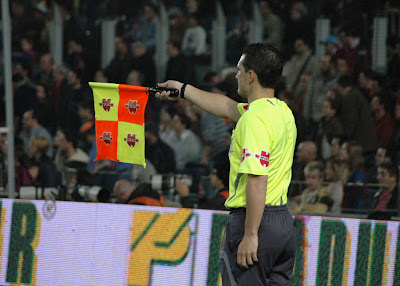The Offside Rule in Soccer - What Does It Mean to be Offside?
Ah, one of the most confusing rules in all of sports. The good ol' offside rule in soccer. Is there really anything else like it? Perhaps its controversy came to an all-time high during the 2010 World Cup in South Africa when Maurice Edu was denied a goal off of Landon Donovan's free kick. The ref disallowed the goal and gave no reason, merely a presumed offside decision. A similar decision was also made against the Yanks during the World Cup when Clint Dempsey was denied a goal against Algeria for supposedly being offside during Herculez Gomez's cross. What's the big deal and why's it all so confusing? Why do these "errors" have to occur? Was there a conspiracy against the US during the World Cup? Of course not.Soccer relies on linesmen and the eyes of the ref rather than instant replays. There has been an outcry for video technology to enter into the beautiful game, especially after the various gaffs during the World Cup, but don't hold your breath. Such issues have been part of the game since its inception, and some American publicity isn't going to much to change that. To some, such as vocal American soccer hater Jim Rome, this makes the game come off as primitive. To others, it's just part of the game. It's a hard pill to swallow for some American fans, but once you understand the offside rule in soccer, it's easy to get past.
The simplest, most stripped down kitchen-table definition of the offside rule is as follows:
A player cannot be past the last defender on the opposing team at the time that the ball is being passed to that player.
Of course there's some interpretations and complications in regards to "active play" and changes in the Laws of the Game (two points which we'll get to later). The idea of the offside rule is to keep an attacking player from simply sitting behind the defenders and waiting for a ball to get lobbed to him. With the offside rule, nothing would really keep him from doing so. The whole thing seems more complicated than it really is because we typically aren't aware that a player is offside until it actually happens. We simply see a ball in the air and a striker beating the defenders and he gets a touch and WHIIIIIIIISTLE and FLAAAAAG GOES UP and so on. We're disappointed, we're confused, we declare the call is rubbish, and then we see the replay and hang our heads between our legs.
It takes patience to understand, but the more you watch the game it's something that you get used to. Regardless of league or skill, whether it's a high school soccer team or Barcelona, there will be offside calls. It happens to the best of players, and it's almost always caught. The linesmen are essentially used to make sure the right call is made, and it's clear to see why their jobs are so important.
These free-use diagrams are useful in understanding the offside rule:
In the first diagram, the blue forward (past the dotted line) is in an offside position because he's past the last red defender. While he's in an offside position, he hasn't committed an offside offense because the ball hasn't been passed to him yet. If it was, though, he would be considered active in the play and therefore be called offside.
 |
| Offside! |
In this diagram, however, the blue forward in the box is NOT offside. Why? He's behind the ball. Because of this he's not in an offside position and therefore could receive a cross without penalty:
 |
| Not offside! |
Refs still make the wrong call all the time because human error is inevitable. Here's a video of Clint Dempsey's disallowed goal from the World Cup:
Despite popular belief, though, refs do get it right! Here's an example:
Vela if offside because he's behind the goalie who has become the 2nd to last defender.
Confusing, isn't it?
Read more on the offside rule in soccer and FIFA's Laws of the Game.
